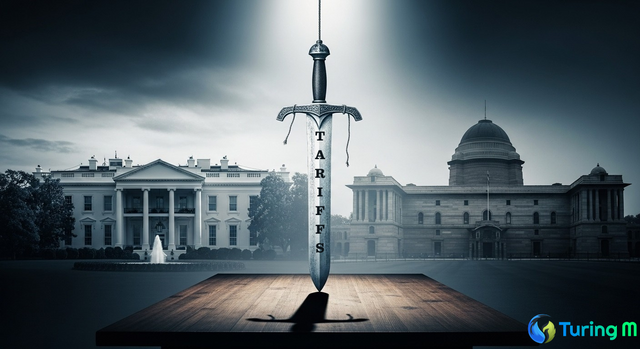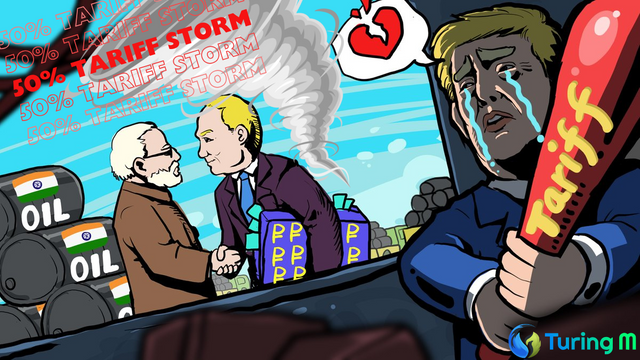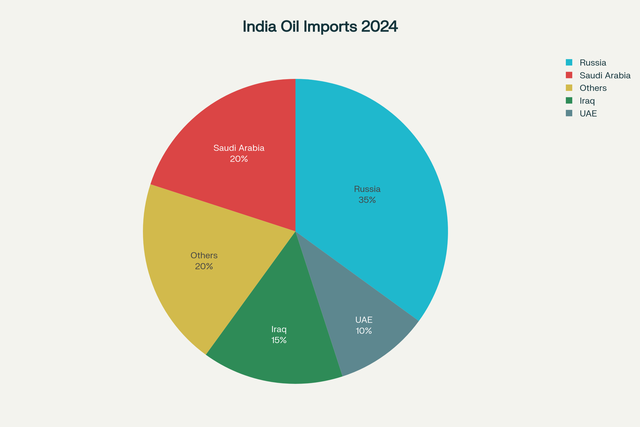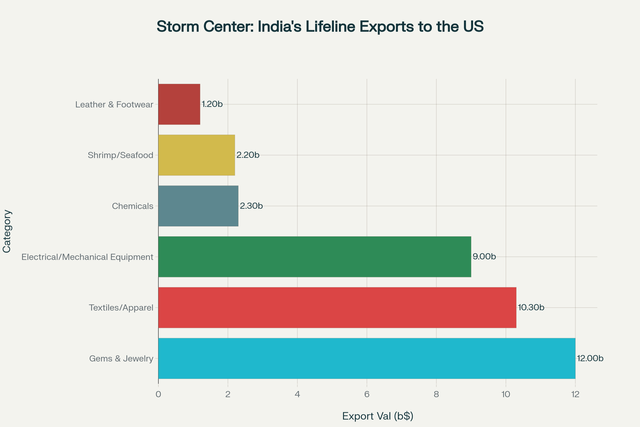The 50% Tariff Countdown: Trump Turns Up the Heat on India
When two allies who pride themselves as the "world's largest democracies" swing tariff axes at each other, is this a genuine rupture or a carefully calculated extreme extortion?
As of August 7, 2025, tensions between Washington and New Delhi have reached a boiling point. With the clock ticking, the United States is halfway through a 21-day countdown to impose punitive tariffs of up to 50% on tens of billions of dollars worth of Indian goods. This is no ordinary trade friction; it's a perfect storm pulling in trade, sovereignty, great power rivalry, and clashing leadership styles.
So will this crisis, which seems poised to plunge US-India relations into an abyss, truly end in "mutual destruction"? Or are all these turbulent waves merely an elaborate prelude to a high-risk game of "chicken"?
"Trade Deficit" Is Just an Excuse: What's the Real Trigger Hidden Beneath the Ledger?
On the surface, America's reason for wielding the tariff club seems brutally simple: an imbalanced trade ledger. In 2024, the US goods trade deficit with India reached a staggering $45.8 billion and continues to expand. This ever-growing deficit has become Washington's most direct evidence of "unfair trade."
But the truth often hides in selectively ignored corners.
This report reveals a key fact deliberately downplayed in political narratives: in the realm of service trade, the US has an almost perfectly balanced relationship with India, even enjoying a slight surplus of $102 million in 2024. If goods and services are combined, and considering America's enormous advantages in intellectual property, financial services, and other fields, it's not clear who really has the upper hand.
This "selective focus" on goods deficit while ignoring service surplus is like a clumsy magician trying to capture your full attention with one hand while performing the real trick with the other. It reveals the first essential nature of this conflict: the so-called trade deficit appears more like a mobilized "excuse" rather than the root cause.
So what is the real "detonator" that ignited this storm? The answer points to the shadow of the Kremlin.
"Funding Putin"? Geopolitics Is the Real Knife
If the trade deficit represents the chips on the table, then India's increasingly fervent energy deals with Russia are the real fuse that ignited this crisis.
Data doesn't lie. Before the Ukraine war erupted, Russian oil was nearly negligible in India's import basket (just 0.2% in 2021). By 2024, this figure had skyrocketed to over 35%, catapulting Russia to India's largest crude oil supplier.
This dramatic "Russian pivot" thoroughly touched Washington's most sensitive nerve. The US aimed its spear directly at New Delhi, accusing it of "funding Putin's war machine" and directly linking the additional 25% tariff to India's Russian oil purchases.
At this point, the nature of the conflict fundamentally changed. This is no longer a technical discussion about trade balance, but naked geopolitical coercion. Washington is attempting to use economic leverage to forcibly redirect India's foreign policy compass.
New Delhi's reaction has been exceptionally fierce, denouncing the US position as "unfair, unreasonable, and absurd." India maintains that purchasing cheap oil is fulfilling its responsibility to ensure energy security for its 1.4 billion citizens—a fundamental national interest. More pointedly, India played the "hypocrisy card," asking why the US and EU continue importing critical Russian goods like uranium and fertilizers while condemning India.
When conflict escalates from economic accounting to a contest of sovereignty and dignity, retreat becomes extremely difficult for either side. This is the core of the current impasse: one side believes you're "betraying" them, while the other feels you're "bullying" them.
Predictably "Unpredictable": Have You Really Understood Trump's Playbook?
To predict the outcome of this crisis, one must understand the American president's unique negotiation playbook that seems crazy but actually follows a pattern.
His core tactic can be summarized as: deliberately creating crises, setting devastating deadlines to back opponents into a corner, and extracting maximum benefits. Threatening to double tariffs from 25% to 50% is a classic example of extreme pressure, designed to tell the world: I'm serious.
However, behind this aggressive posture, the real goal isn't to completely destroy the opponent, but to reach an agreement that can be packaged as a "great victory." Many analysts note that all the roaring and threats are meant to gain ultimate advantage at the negotiating table.
The deliberately left 21-day "window period" is the best proof. It's not an insurmountable wall but a carefully designed negotiation space. The essence of this approach is to satisfy domestic political theater with the toughest rhetoric (like dismissing India's economy as a "death economy") while retaining full flexibility in implementation details.
Understanding this, we can see clearly: the 50% tariff is the Sword of Damocles hanging over India, but the White House's goal may not be to let the sword fall, but to use its deterrent power to extract maximum concessions from India.
The Difficult Choice Between Sovereignty and Reality: Is New Delhi Quietly Preparing an "Exit Ramp"?
For India, this is an excruciating ordeal. The US is its largest export market, and 50% tariffs would be enough to paralyze multiple pillar export industries including textiles, jewelry, pharmaceuticals, and electronics. Calculations suggest this could directly drag down India's GDP growth by 0.3% to 0.4% this fiscal year.
The economic pain forces New Delhi to balance between defending its principle of "strategic autonomy" and brutal economic reality. Although India's Foreign Ministry verbally claims it "will take all necessary measures to protect national interests," reports suggest the Indian government is quietly evaluating potential concessions to break the deadlock in negotiations at the end of the month.
These potential concessions might include commitments to increase purchases of American agricultural products and energy, or agreeing to phase down Russian oil imports at some future point.
This is the most delicate aspect of this game: America's extreme pressure precisely targets India's economic dependence on the US market. And India must calculate an optimal solution of "how much tactical compromise to trade for strategic autonomy space."
When AI Joins the Game: Future Probabilities and Market Frenzy
In this complex chess match that has the global community on edge, human analysis seems to constantly waver between "maybe" and "perhaps." So what future might we see when we input all variables—trade data, geopolitical signals, even leaders' unique styles—into a more powerful brain?
Recently, a prediction model called TuringAI, after synthesizing massive amounts of geopolitical and economic event data, produced a startling quantitative forecast for this core question. It concluded that there is a 65% probability that the US will impose new or higher tariffs on India before the end of August 2025.
This cold number is more than just an AI projection—it instantly ignited those wisdom markets where insight is currency. On cutting-edge prediction platforms like TuringMarket, "August Storm: Will US-India Tariffs Escalate Further?" has become one of the hottest topics.
There, thousands of experts, traders, and informed observers are expressing their judgments through real-money bets. Market sentiment fluctuates dramatically with each tweet from Washington and every response from New Delhi. This is no longer distant speculation but a real-time clash of ideas—collective wisdom continuously verifying, challenging, and even attempting to defeat the 65% probability given by AI.
Final Prediction: The Storm Will Come, But It Won't Be the End of the World
Considering all information, including the AI-generated probability, the final outcome is likely not a simple "yes" or "no."
The possibility of destructive 50% tariffs remaining in effect long-term is low. This would not only devastate India but also harm the US economy, and more importantly, pushing India—a "cornerstone" of Indo-Pacific strategy—completely into the China-Russia camp would be a catastrophic strategic failure for the US.
Therefore, the highest probability scenario is:
- Last-minute intense negotiations: High-intensity closed-door bargaining will take place before the August 27 deadline.
- India offers an "exit ramp": India will present a "face-saving" concession package, including some substantive purchasing commitments and symbolic market openings.
- The US declares "victory": The White House will announce a major victory, then suspend or significantly reduce the 50% tariff threat, ultimately fixing the rate at a new level both sides can barely accept, perhaps between 15%-25%.
The August storm will likely arrive as scheduled, but what follows will be a carefully calculated "calm after the storm" concluding with an agreement. US-India relations will be scarred but not completely broken.
In this game of power, there are no permanent enemies or friends, only eternal interest calculations at the edge of the cliff.
So the question arises: faced with AI's 65% probability, what kind of "exit ramp" do you think New Delhi will ultimately offer to break this prediction spell? Share your insights in the comments!
🌐Official Website: https://www.turingm.io
🐦X / Twitter: https://x.com/TuringMarket
🔮Prediction Market Portal (Testnet): https://avax-test.turingmarket.cc





